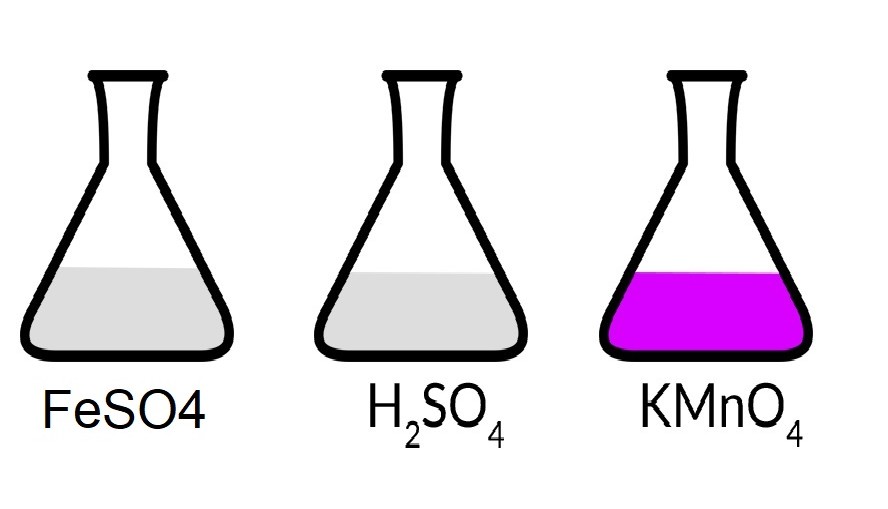Iron(II) sulfate where Iron has an oxidation number of +2 and Potassium permanganate where Mn has an oxidation number of +7, react with each other in an acidic condition. That means FeSO4, KMnO4, and H2SO4 react to produce the Iron(III) sulfate, Manganese sulfate, potassium sulfate as well as water. This is a Redox (oxidation-reduction) reaction.
Iron(II) sulfate react with potassium permanganate and sulfuric acid
Now, if we concentrate on the chemical reaction equation which is our main fact of discussion in this article, we will notice that the Iron (Fe) in the reactant releases one electron in the meantime the Manganese takes up 5 electrons from the reaction. Therefore, it is an oxidation-reduction reaction as the electron transfer occurred in this reaction.
The balanced equation for the reaction discussed above is–
10FeSO4 + 2KMnO4 + 8H2SO4 = 5Fe2(SO4)3 + 2MnSO4 + K2SO4 + 8H2O
Balancing the reaction among FeSO4, KMnO4, and H2SO4
From the above discussion, there is no doubt that the reaction is a redox reaction. As it is an oxidation-reduction reaction, it can easily be balanced by the ion-electron method where we take into concern the number of electron(s) transfers from the reducing agent to the oxidizing agent. So, further not do any delay, let’s get started.
The skeleton formula of the reaction is-
FeSO4 + KMnO4 + H2SO4 = Fe2(SO4)3 + MnSO4 + K2SO4 + H2O
or,
FeSO4 + KMnO4 + H2SO4 = Fe2(SO4)3 + MnSO4 + K2SO4 + H2O
Here FeSO4 is that the reductant because iron released electron and get oxidized in addition as KMnO4 takes electrons from the reducing agent and get reduced, is the oxidant.

Reducing agent: FeSO4 or by excluding the spectrator ion(s) Fe2+
Oxidizing agent: KMnO4 or by excluding the spectrator ion(s) MnO4-1
Reduction Half Reaction
We should know that the oxidizing agents are responsible for the reduction reaction in a redox reaction. Here, in the above reaction manganese takes 5 electrons and the oxidation number becomes +2. So reduction takes place in terms of KMnO4 or MnO4–.
⇒ MnO4 -1 + 5e– + 8H+ = 4H2O + Mn2+ … …. …. …. (1)
Oxidation Half Reaction
On the other hand, the Iron in the reactant part of the reaction released only one electron and produced an iron (III) ion, as it is a reducing agent. The oxidation number of reducing agent iron(II) ion becomes +3 from +2.
⇒ Fe2+ – e– = Fe3+ … … … … … (2)
Adding the oxidation as well as reduction reaction halves to get a full redox reaction
As the oxidizing agent, KMnO4 has to take 5 electrons to become Mn+2, on the country, the reducing agent iron (II) sulfate releases only one electron to get oxidized. So there are five times reducing agents needed to reduce the KMnO4. Therefore, we should multiply the number (2) equation by 5 and then add them together to get the full oxidation-reduction reaction.
Now equation (1) + (2)x5,
MnO4 -1 +5e– + 8H+ = 4H2O + Mn2-
5Fe2+ – 5e– = 5Fe3+
MnO4 -1 + 5Fe2++ 8H+ = Mn2- + 4H2O + 5Fe3+
Now adding necessary ions and radicals we get,
5FeSO4+ KMnO4 + 4H2SO4 = MnSO4 + 5/2Fe2(SO4)3 + 4H2O +K2SO4
Or,
10FeSO4 + 2KMnO4 + 8H2SO4 = 5Fe2(SO4)3 + 2MnSO4 + K2SO4 + 8H2O
“Answer”
10FeSO4 + 2KMnO4 + 8H2SO4 = 5Fe2(SO4)3 + 2MnSO4 + K2SO4 + 8H2O
Follow us on Twitter, Facebook, Linkedin and Tumbler
Read More
K2Cr2O7 + FeSO4 + H2SO4 = Cr2(SO4)3 + Fe2(SO4)3 + K2SO4 + H2O


Leave a Reply